- Top Employee Onboarding Software
- Why Use Employee Onboarding Software?
- Key Features of Effective Onboarding Software
- How To Choose The Right Onboarding Software?
- Which is the Best Onboarding Software?
- Frequently Asked Questions (FAQs)
- What Is Upskill And Reskill?
- Difference Between Reskilling And Upskilling
- Upskilling for Workplace Advancement
- Reskilling for Career Transformation
- Crafting Successful Upskill and Reskill Strategies
- Upskill And Reskill Strategizing: Things to Keep in Mind
- Measuring the Impact of Skill Development Initiatives
- Frequently Asked Questions
- What’s a Skill Gap?
- Employee Skill Gap Analysis: Why Do We Need It?
- How To Conduct Employee Skill Gap Analysis?
- Addressing Skill Gaps Through Training and Hiring
- Utilizing Skills Gap Analysis for Strategic Planning
- Leveraging Employee Skill Gap Analysis: Things To Keep In Mind
- Frequently Asked Questions
- Transformative Role of AI in Talent Acquisition
- Impact of AI on Business Recruiting
- Overcoming Challenges in AI-Driven Talent Acquisition
- Starting with AI in Talent Acquisition
- Future Landscape of AI in Talent Acquisition
- Frequently Asked Questions
- HR In The Hot Seat - Challenges With Evolving Workforce
- Mastering Effective HR Management: Tips For Overcoming Challenges
- Summing Up
- The Future of HR: Key Trends for 2024
- Skill-Based Hiring
- Prioritizing Employee Experience, Engagement & Well-being
- AI-Empowered Workforce Evolution and Its Impact
- Taking Diversity, Equity, and Inclusion Beyond Mandates
- Hybrid and Remote Work
- Embracing the Gig Economy and Blended Workforce
- Transparent HR Practices
- Climate Change Adaptation in HR Practices
- Leveraging HR Analytics for Data-Driven Decisions
- Continuous Learning & Development to Improve Productivity
- The Office Buzz in 2024
- Bottom Line - HR Operating Model Needs A Shift
- Importance and Impact of Recognizing Employee Birthdays
- Professional Birthday Wishes for Employees (All Experience Levels)
- Personalized Birthday Wishes for Employees in Different Roles
- Fun Birthday Wishes for Employees (with Templates)
- Birthday Wishes for Remote Employees
- Heartfelt Birthday Wishes for Employees
- Belated Birthday Wishes for Employees
- Simple & Sweet Birthday Wishes for Employees
- Celebrating Employee Birthdays: Ideas and Traditions
- Tips and Ideas for Sending Birthday Wishes to Employees
- Closing Thoughts
- Frequently Asked Questions
- What Is An Employee Referral?
- Benefits of Implementing Employee Referral Programs
- Setting Up an Effective Employee Referral Program
- Employee Referral Email
- Employee Referral Scheme
- Overcoming Challenges of Employee Referrals
- Companies with Best Employee Referral Programs
- Employee Referral Programs: Best Practices
- Closing Thoughts
- Frequently Asked Questions (FAQs)
- Importance of Team Building Activities
- Types of Team Building Activities
- Outdoor Team Building Activities for Employees
- Indoor Team Building Activities for Employees
- Easy Team Building Activities for Remote Employees
- Team Building Activities For New Employees (Icebreakers)
- Fun Team Building Activities for Different Goals
- To Boost Communication and Collaboration
- To Reduce Stress Levels and Promote Well-being
- Aligning Team Purpose and Values with Strategic Activities
- Final Remarks
- Frequently Asked Questions
- Importance of Employee Appreciation Quotes
- Work Appreciation Quotes for Employees
- Employee Appreciation Quotes for Hard Work Recognition
- Employee Appreciation Quotes for Teamwork and Collaboration
- Appreciation Quotes for Celebrating Employee Anniversaries and Milestones
- Employee Appreciation Quotes for Strong Work Ethics
- Employee Appreciation Quotes for Project & Goal Completion
- Employee Appreciation Quotes for Quality of Work
- Employee Appreciation Quotes for Creativity and Innovation
- Appreciation Quotes for Managers
- Peer-to-Peer Employee Appreciation Quotes
- Appreciation Quotes for Employees Leaving the Company
- Employee Appreciation Quotes for Thoughtful Gestures
- Funny Employee Appreciation Quotes
- Short Employee Appreciation Quotes
- Employee Appreciation Quotes for Different Roles
- Employee Appreciation Quotes for Senior Leadership
- Creative Ways to Use Employee Appreciation Quotes
- Summary
- Frequently Asked Questions (FAQs)
- What is Employee Satisfaction?
- Importance of Employee Satisfaction
- Objectives of Employee Satisfaction
- Employee Satisfaction vs. Employee Engagement
- Key Reasons for Employee Dissatisfaction
- Strategies for Improving Employee Satisfaction
- Ways to Measure Employee Satisfaction
- Best Practices for High Employee Satisfaction
- Final Remarks
- Frequently Asked Questions (FAQs)
- How to Craft Effective Employee Appraisal Comments
- Key Areas to Focus in Performance Review
- Comments On Hard Work & Dedication
- Assessing Interpersonal Skills
- Evaluating the Ability to Collaborate & Work in Teams
- Gauging Punctuality
- Commenting on Communication Style
- Reviewing Time Management and Productivity
- Leadership in Performance Appraisals
- Assessing Creativity & Innovation
- Evaluating Problem-Solving Abilities
- Recognizing Flexibility and Dependability in Reviews
- Employee Appraisal Comments for Different Roles
- Summary
- Frequently Asked Questions (FAQs)
- Employee Grievance Meaning
- Importance of Employee Grievance Process
- Types of Workplace Grievances
- Reasons for Employee Grievances
- Employee Grievance Procedure
- Steps in the Employee Grievance Handling Process
- Employee Grievance Form Example
- Final Remarks
- Frequently Asked Questions (FAQs)
- What is Company Culture?
- Importance of Company Culture
- Types of Company Culture
- Factors Contributing to Organizational Culture
- Assessing & Developing Corporate Culture
- Company Culture - It’s not just Perks or Feels
- Good Company Culture Examples
- Developing Company Culture: Best Practices
- Closing Thoughts
- Frequently Asked Questions (FAQs)
- What is Employee Empowerment?
- Benefits of Empowering Employees
- Employee Empowerment vs. Micromanagement
- Strategies for Effective Employee Empowerment
- Role of Managers in Fostering Empowerment
- Organizational Structure Supporting Empowerment
- Overcoming Barriers to Employee Empowerment
- Frequently Asked Questions (FAQs)
- What is Employer Branding?
- Importance of Employer Branding Strategy
- How to Build an Employer Branding Strategy?
- Strategies for Building a Strong Employer Brand
- How to Measure and Boost Your Employer Branding Success?
- Examples of Strong Employer Brand Strategy
- Best Practices for an Effective Employer Branding Strategy
- Closing Thoughts
- Frequently Asked Questions (FAQs)
- What are Employee Wellness Programs?
- Importance of Employee Wellness Programs
- Examples of Employee Wellness Programs
- Real-Life Examples of Corporate Wellness Programs
- Strategies for Encouraging Participation
- Supporting Diverse Employee Needs
- Creating Comprehensive Wellness Programs
- Measuring the Impact on Business and Employees
- Closing Thoughts
- Frequently Asked Questions (FAQs)
- What is Talent Management?
- Developing a Winning Talent Management Strategy
- Models and Frameworks
- Tips for Framing Effective Talent Management Strategy
- Looking Ahead: Recent Trends in Talent Management
- Frequently Asked Questions
- Role of AI in HR: Addressing Common Challenges
- Artificial Intelligence in HR Processes
- AI Tools for HR Functions
- How to Adopt AI in HR?
- Addressing Challenges of AI in HR
- Ethical and Responsible AI Use
- The Future of AI in HR
- Closing Thoughts
- Frequently Asked Questions
- What is Performance Management?
- Elements of Effective Performance Management
- Performance Management Cycle
- Differentiating Performance Management
- Benefits of Performance Management With Examples
- Challenges faced in Performance Management and their Solutions
- Future Trends in Performance Management
- Frequently Asked Questions
- Changing Role of HRM
- Changing Role Of HR Manager
- Technology and the Changing Role of HRM
- The Rise of AI and Machine Learning in HR
- Mobile Technology's Impact on HR Practices
- The Significance of People Analytics in HR
- Navigating the Future of HR Technology
- Final Remarks
- Frequently Asked Questions
- Compensation Management Meaning
- Compensation Types
- Breaking Down The Compensation Management Process
- HR Software for Compensation Management
- Current Trends in Compensation Management
- Frequently Asked Questions
- Defining Flexible Work Arrangements
- Flexible Working: Advantages for Businesses
- Challenges of Flexible Work Arrangements
- Crafting Flexible Working Practices
- Types Of Flexible Work Arrangements
- Comparing Flexible Work Arrangements
- Real-Life Examples of Flexible Work Arrangements
- Final Remarks
- Frequently Asked Questions
- Conflict Resolution Meaning
- Conflict Origins
- Tried & Tested Conflict Resolution Strategies
- Methods of Conflict Management at Workplaces
- Conflict Resolution Strategies: Top Management Tips
- Summary
- Frequently Asked Questions
- Career Development Meaning
- Career Development Plan for Employees
- Career Development in HRM: Growth Ideas For Employees
- Issues in Career Development and Their Solutions
- Closing Thoughts
- Frequently Asked Questions
- Understanding Compensation
- Exploring Benefits
- Difference between Compensation and Benefits
- Compensation & Benefits Structure
- Final Remarks
- Frequently Asked Questions
- Defining Recruitment in HR Practices
- Exploring Talent Acquisition in HR
- Understanding Talent Acquisition vs Recruitment
- When to Recruit or Acquire Talent
- Talent Acquisition vs Recruitment: Responsibilities
- From Recruitment To Talent Acquisition
- Closing Thoughts
- Frequently Asked Questions
- Work Culture Meaning
- Types of Work Cultures
- Components of Culture
- Best Work Culture Examples Set By Top Companies
- Creating a Positive Work Culture
- Closing Thoughts
- Frequently Asked Questions
- Defining Learning vs Development
- Importance of Learning and Development
- L&D Activities for Employees
- Choosing the Right L&D Activities
- Crafting an Effective L&D Strategies
- Aligning L&D Strategy with Business Goals
- Designing Engaging Learning Journeys
- Learning and Development Process: KPIs
- ROI in Learning and Development
- Emerging Trends in L&D
- Closing Thoughts
- Frequently Asked Questions
- What Is Leadership Development?
- Key Skills for Leaders
- How To Develop Leadership Skills in Organizations?
- What Is A Leadership Development Program?
- How To Develop A Leadership Development Program?
- Example of A Leadership Development Plan
- Benefits of Leadership Development Training
- Frequently Asked Questions
- Defining Diversity Training
- Importance of Diversity Training
- What are the Types of Diversity?
- Types of Diversity Training Methods
- Diversity Training Activities
- Choosing A Diversity Training Program
- How to Implement Diversity Initiatives
- Best Diversity Training Programs (Real-Life Examples)
- Improving the Effectiveness of Diversity Training
- Tracking and Evaluating the Results of DE&I Training Efforts
- Essential Elements for Successful Diversity Training
- Closing Thoughts
- Frequently Asked Questions
- Defining Occupational Health & Safety
- Evolution of Workplace Health and Safety
- Identifying Common Workplace Hazards
- Global Impact on Occupational Health & Safety
- Managing Employee Health and Safety Risks
- Occupational Health and Safety Problems
- Future of Occupational Health and Safety
- Frequently Asked Questions
- Employee Orientation Defined
- Employee Onboarding Explained
- Orientation and Onboarding: Understanding the Difference
- Importance of Orientation and Onboarding
- Crafting Comprehensive Integration Strategies
- Quick Tips for Orientation and Onboarding
- Frequently Asked Questions
- What is HR Metrics?
- Importance of HR Metrics
- HR Metrics Examples in Recruitment
- HR Metrics Examples in Employee Retention
- HR Metrics Examples in Revenue
- Other Common HR Metrics
- Soft HR Metrics Example
- HR Metrics Formula
- Utilizing HR Metrics Effectively
- Future of HR Metrics
- Summary
- Frequently Asked Questions
- Defining Decision Making Process
- Key Concepts In Decision Making
- Decision Making & Problem Solving
- Tips For Improving Decision Making Skills
- Selected Practice Questions & Answers
- Conclusion
- Frequently Asked Questions (FAQs)
- A case(s) of miscommunication
- The devil is in the (resume) details
- One for the complaints!
- What is an Exit Interview?
- Benefits of Exit Interviews to an Organization
- How to Conduct Exit Interviews?
- Exit Interview: Sample Questions to Ask
- Overcoming Challenges of Exit Interviews
- Exit Interviews: Best Practices
- Closing Thoughts
- Frequently Asked Questions
- Technology in the Workplace
- Benefits of Tech Integration
- Technology in the Workplace: Key Functions
- How Technology Normalized Remote Work
- Workplace Technology: Top Tools and Software
- Steps for Effective Technology Implementation
- Overcoming Tech Implementation Challenges
- Ethical Considerations in Tech Use
- Keeping Pace with Tech Trends
- Closing Thoughts
- Frequently Asked Questions
- What is Ethical Leadership?
- Principles of Ethical Leadership
- Difference between Ethics and Integrity
- Importance of Ethical Leadership
- Ethical Leadership in Practice
- Overcoming Challenges
- Frequently Asked Questions
- Embracing Change Management
- Mastering People Analytics
- Enhancing Stakeholder Relationships
- Navigating Diversity, Equity & Inclusion
- Upholding Ethics and Data Privacy
- Developing Critical Thinking
- Advancing Negotiation Techniques
- Fostering Inter-departmental Collaboration
- Building Resilience in HR
- Frequently Asked Questions
- What is Mental Health?
- Benefits of a Mentally Healthy Workforce
- Prioritising Mental Health: Creating a Culture of Support
- Final Remarks
- Frequently Asked Questions
- Gen Z vs Millennials - What is the difference?
- Retain and Engage Gen Z Employees: Need and Strategies
- Strategies to Retain and Engage Gen Z Employees
- Rethinking Requirements
- Final Remarks
- Frequently Asked Questions
- Understanding Millennial Leadership Needs
- Key Leadership Skills for Millennials
- How To Develop Millennial Into Leaders
- Additional Strategies to Develop Leaders
- Learning Preferences of Millennials
- Benefits of Investing in Millennial Leaders
- Closing Thoughts
- Frequently Asked Questions
- Understanding Fluff
- Examples of Interview Fluff
- Identifying Interview Fluff
- Addressing Interview Fluff
- Seeing Through the Fluff
- Frequently Asked Questions
- What is the Gender Pay Gap?
- Is the Gender Pay Gap Real?
- Factors Affecting the Gender Pay Gap
- How Age Impacts Women’s Earnings
- The ‘Motherhood Penalty’
- Education's Role in Wage Differences
- Racial and Ethnic Disparities in Pay
- Closing the Gender Gap
- Frequently Asked Questions
- Top Weirdest Late-To-The-Office Excuses
- The Fine Art of Balancing Wit and Wisdom in HR
- Understanding Social Media Recruiting
- Crafting Your Social Media Recruitment Strategy
- Implementing Your Strategy Effectively
- Popular Platforms for Recruitment
- Navigating the Downsides of Social Media Recruiting
- Measuring Success and Adjusting Strategy
- Summary
- Frequently Asked Questions
- Who Is A High Potential (HIPO) Employee?
- Characteristics of A High Potential (HIPO) Employee
- High Potential Employee Identification
- Grooming High Potential Employees
- Why High Potential Employees Leave
- How Do You Retain High Potential Employees?
- High Potential Employee Development: Best Practices
- Closing Thoughts
- Frequently Asked Questions
- What is Digital Fluency?
- Why Digital Fluency Matters?
- Difference between Digital Literacy and Digital Fluency
- Key Components of Digital Fluency
- Achieving Digital Fluency
- Overcoming Challenges
- Future of Workforce Digital Fluency
- Frequently Asked Questions
- What is Loud Quitting?
- Pros and Cons of Loud Quitting
- Reasons Behind the Trend
- Analyzing the Impact
- How HR Can Navigate the Loud Quitting Uproar
- Preventive Strategies
- Closing Thoughts
- Frequently Asked Questions
- Defining Emotional Intelligence in HR
- Why Emotional Intelligence Matters for HR Leaders
- How To Build Emotional Intelligence in HR
- Integrating EQ into HR Practices
- Impact of EQ on Company Culture
- Emotional Intelligence in HR: Major Challenges
- Final Remarks
- Frequently Asked Questions
- Understanding Internal Job Posting
- Internal Job Posting: Pros and Cons
- The Internal Job Posting Process
- Writing Effective Ads for Internal Job Posting
- Strategies for Success of Internal Job Posting
- Summary
- Frequently Asked Questions
- Understanding Workplace Bias
- Common Types of Bias in HR
- Closing Thoughts
- Frequently Asked Questions
- What is a Dry Promotion?
- Dry Promotion: Pros and Cons for Companies
- Impact of Dry Promotion on Employee Retention
- Preventing Talent Loss After Dry Promotions
- Closing Thoughts
- Frequently Asked Questions
- What Is A Stay Interview?
- Importance Of Stay Interviews
- Benefits And Challenges Of Stay Interviews
- Planning And Conducting Stay Interviews
- Stay Interviews: 20 Sample Questions To Ask
- Best Practices For Effective Stay Interviews
- Summary
- Frequently Asked Questions
- Who Is A Boomerang Employee?
- Reasons For Returning
- Benefits Of Hiring Boomerang Employees
- Challenges Of Rehiring
- Interviewing Boomerang Candidates: Sample Questions
- Enhancing The Hiring Process
- Making Informed Decisions
- Final Remarks
- Frequently Asked Questions
- Talent Pipeline Meaning
- Significance of Talent Pipelines
- Advantages of a Talent Pipeline
- Building a Talent Pipeline
- Maintaining a Talent Pipeline
- Attracting Top Talent
- Implementing the Strategy
- Frequently Asked Questions
- What is Micromanagement?
- Recognizing Micromanagement
- Leadership versus Micromanagement
- Keeping Micromanagement in Check
- Beyond Micromanagement
- Summing Up
- Frequently Asked Questions
- Recognizing Signs Of A Bad Hire
- Understanding The Impact On Teams
- Dealing With A Bad Hire
- Preventing Future Bad Hires
- Closing Thoughts
- Frequently Asked Questions
- Defining Neurodiversity
- Importance of Neurodiversity in the Workplace
- Moving Towards Inclusive Environments
- Final Remarks
- Frequently Asked Questions
- Understanding the Generation Gap
- Multigenerational Workforce: Debunking Stereotypes
- Strategies for Bridging the Gap
- Benefits of a Multigenerational Workforce
- Final Remarks
- Frequently Asked Questions
- Defining Productivity Theatre: All Show, No Go
- 5 Key Drivers of Fake Productivity
- Solutions to Combat Productivity Theatre
- Summary
- Frequently Asked Questions
- Defining Grumpy Staying
- Why do Grumpy Stayers not Leave?
- Recognizing the Signs
- Exploring the Causes
- Understanding the Impact
- Addressing the Issue
- Taking Action: Addressing Grumpiness with Empathy
- After the Conversation
- When Grumpy Staying Continues
- Closing Thoughts
- Frequently Asked Questions
- The Rationale Behind Office Peacocking
- Impact on Company Culture
- Impact on Employees
- Case Studies: Examples of Office Peacocking
- The Downside: Potential Pitfalls of Office Peacocking
- Practical Tips for Implementing Office Peacocking
- Frequently Asked Questions
- 13 Common Mistakes Young Managers Make
- Strategies To Avoid Mistakes (Individual Growth)
- How Young Managers Can Boost Teamwork
- Learning From Errors
- Summary
- Frequently Asked Questions
- Understanding Great Regret - What causes the shift shock?
- Impact of Great Regret
- How can HR help make the situation better?
- Closing Thoughts
- Frequently Asked Questions
- Understanding the HR Budget
- Key Components of an HR Budget
- Preparing an HR Budget Step-by-Step
- Importance of HR Budgeting in Management
- Final Remarks
- Frequently Asked Questions
- What are Pre-Employment Assessments?
- Importance of Pre-Employment Testing
- Types of Pre-Employment Assessments
- 15 Tips for Creating Effective Pre-Employment Assessments
- Closing Thoughts
- Frequently Asked Questions
- Exploring the Productivity Paradox
- Understanding the Impact of Solow Paradox
- Productivity Paradox: Why it Matters for Recruiters & HRs
- Identifying Causes and Challenges
- Strategies for Enhancing Productivity
- AI & the Modern-Day Productivity Paradox
- Beyond Technology: Building a Productive Workforce
- Summary
- Frequently Asked Questions
- Understanding the Great Reshuffle 2.0
- Preparing Leaders for the Change
- HR’s Role in Handling Great Reshuffling 2.0
- The Way Ahead
- Frequently Asked Questions
- Definition Of Managerial Grid
- Managerial Grid Theory Explained
- Application Of Managerial Grid
- Criticisms And Limitations
- Evolution And Contemporary Perspectives
- Integrating Managerial Grid With Other Models
- Practical Steps For Implementing Managerial Grid
- Conclusion
- Frequently Asked Questions
- Understanding Skills Taxonomy
- Why do we Need Skills Taxonomy?
- Benefits of Skills Taxonomy
- Components of Skills Taxonomy
- Building a Skills Taxonomy: A Step-by-Step Guide
- Skill Taxonomies vs Intelligence Tools
- Closing Thoughts
- Frequently Asked Questions
- Definition Of Team Building
- Stages Of Team Development
- Top 10 Strategies For Effective Team Building
- Team Building Activities
- Best Practices For Effective Team Building
- Setting Team Building Objectives
- Challenges In Team Building
- Conclusion
- Frequently Asked Questions (FAQs)
- Defining Job Shadowing
- Unpacking the Benefits
- Setting Up the Experience
- Job Shadowing vs Internship
- Dos and Don'ts for HR Professionals
- Closing Thoughts
- Frequently Asked Questions
- Employee Journey Mapping: Meaning & Importance
- Stages of the Employee Journey
- Steps for Effective Mapping
- Employee Journey Map: Where does it begin?
- Employee Journey Map: Template
- Best Practices & Tips
- Summary
- Frequently Asked Questions
- Why are Performance Appraisals needed?
- Evolution of Performance Management
- Modern Performance Practices
- Benefits of Modern Performance Appraisals
- The Future
- Frequently Asked Questions
- Is Experience the Sole Indicator of Success?
- Why Hire Inexperienced Talent?: Key Advantages
- Skills to Look For in Inexperienced Talent
- Challenges and Considerations in Hiring Inexperienced Talent
- Final Remarks
- Frequently Asked Questions
- What is a Company Retreat?
- Company Retreat Ideas: Team-Building & Exploration
- Relaxation and Celebration
- Planning Your Retreat: Things to Keep in Mind
- Closing Thoughts
- Frequently Asked Questions
- Understanding HR Forecasting
- HR Forecasting Key Concepts
- Steps for Implementing HR Forecasting
- Common HR Forecasting Methods
- Closing Thoughts
- Frequently Asked Questions
- What is ESG?
- HR and ESG - Why Care?
- ESG in HR Strategy
- Challenges for HR
- Future of ESG in HR
- Frequently Asked Questions
- Defining the Great Betrayal
- Reasons for Its Spread
- Impact on Workers
- Impact on Corporations
- Rebuilding Trust & Valuing Employees
- Closing Thoughts
- Frequently Asked Questions
- Importance of Clear Expectations
- Setting Expectations Early
- Communicating Expectations Effectively
- Differentiating Expectations
- Reviewing and Adjusting Expectations
- Summing Up
- Frequently Asked Questions
- Understanding KRA Frameworks And Models
- KRAs vs KPAs and KPIs
- Monitoring and Tracking KRAs
- KRAs in Various Roles
- Impact of KRA Frameworks and Models on Organizational Success
- Frequently Asked Questions
- Where: The Place of Work
- When: The Time of Work
- How Much Work: Alternate Employment Models
- Who Does the Work: Intelligence
- Designing Organizations with the Four Dimensions of Work
- Summing Up
- Simplifying Processes: The Foundation of Efficiency
- Reducing Unnecessary Meetings: Reclaiming Valuable Time
- Building Strong Accountabilities: Ensuring Responsibility
- Role of HR in Addressing Inefficiencies
- Continuous Improvement: A Commitment to Excellence
- Leadership's Role in Driving Efficiency
- Conclusion: A Holistic Approach to Efficiency
- Understanding Financial Freedom
- Benefits of Empowering Employees Financially
- Empowering Employees Through Financial Literacy
- Financial Topics That Need Attention Based On Career Stage
- Summing Up
- Frequently Asked Questions
- Defining Employee Voice
- Benefits of Amplifying Employee Voice
- Strategies and Tools
- Encouraging Participation
- Closing Thoughts
- Frequently Asked Questions
- Appraisal Blues: Signs of Unhappy Employees
- Addressing Unhappiness Post-Appraisal
- Non-Monetary Solutions for Dissatisfied Employees
- Summing Up
- Frequently Asked Questions
- Women in the Middle Eastern Workforce
- Importance of DEIB
- Role of HR in Building Inclusive Workplaces for Women
- Measuring Inclusion Progress: Key Metrics
- Closing Thoughts
- Frequently Asked Questions
- Preparing for the Conversation
- Conducting the Conversation
- Best Practices for the Talk
- After the Conversation
- Helping Employees Grow
- Frequently Asked Questions
- Understanding HR Exhaustion
- Factors Leading To HR burnout
- Impact Of HR Burnout
- Strategies To Prevent And Manage HR Burnout
- Role Of Technology In Preventing Burnout
- Celebrating HR Successes
- Summary
- Frequently Asked Questions
- Common Mistakes When Hiring Young Talent
- Building Connections with Candidates
- Summary
- Frequently Asked Questions
- Walking a mile in the employee’s shoes
- Conducting Humane Layoffs
- Remote Layoffs Management
- Supporting Laid-off Workers
- Managing the Aftermath
- Wrapping Up
- Frequently Asked Questions
- Importance of Shortening Time-to-Hire
- Shortening Hiring Time: Pre-Application Stage
- Reducing Hiring Time: Application Stage
- Hacks to Shorten Hiring Time: Interview Stage
- Reducing Hiring Time: Offer Stage
- 5 Other Important Hacks & Strategies
- Final Remarks
- Frequently Asked Questions
Transforming Hiring Landscape - Harnessing AI And ML For Talent Acquisition
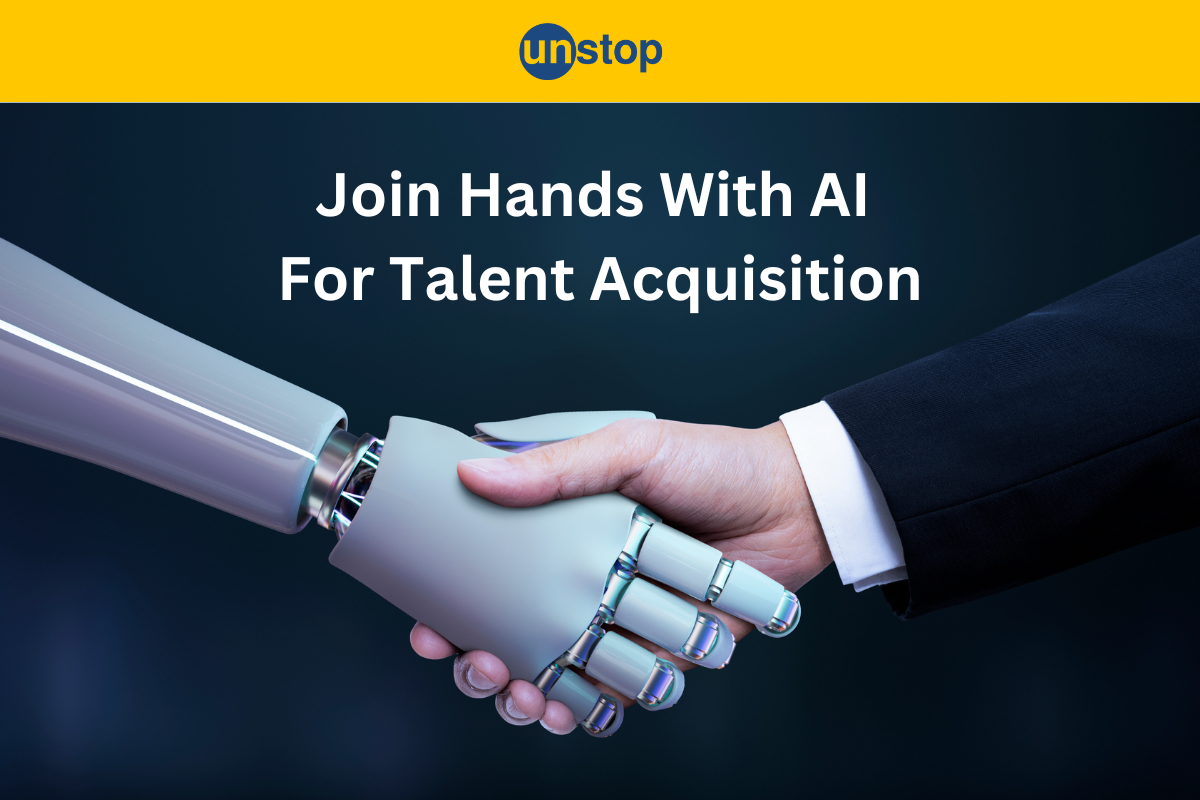
Is your company struggling to find the right talent in a competitive industry? Are you tired of spending countless hours sifting through resumes and conducting repetitive interviews? AI can be the solution to your woes.
Artificial Intelligence (AI) in talent acquisition is revolutionizing the way companies manage their hiring process. From streamlining candidate screening to optimizing interview questions, AI offers numerous benefits for recruiters and HR professionals. With AI-powered tools and platforms, you can efficiently identify top candidates, assess their skills and experience, and make data-driven decisions at every stage of the recruitment process. This article highlights how AI is transforming talent acquisition and gaining a competitive edge in today's business landscape.
Transformative Role of AI in Talent Acquisition
Artificial Intelligence (AI) is revolutionizing the field of talent acquisition, offering numerous benefits to organizations seeking to streamline their hiring processes, increase accuracy, and enhance candidate experience. Below are a few advantages that AI offers:
Streamlining the Hiring Process
AI plays a crucial role in streamlining the hiring process by automating repetitive tasks. Through automated workflows, manual errors are reduced, saving valuable time for HR professionals. AI-powered tools simplify candidate screening and selection, analyzing resumes and applications to identify top candidates efficiently.
Check Out How You Can Hire Faster With Unstop! Click here to explore
Increasing Hiring Accuracy
Utilizing AI technology improves hiring accuracy by analyzing large volumes of data. Predictive analytics help identify top-performing candidates based on historical data patterns and success metrics. By leveraging AI algorithms, organizations can minimize bias in candidate evaluation, ensuring fair assessments that focus solely on qualifications and skills.
Enhancing Candidate Experience
AI also enhances the candidate experience throughout the recruitment journey. Personalized interactions are made possible through AI-powered chatbots that provide instant responses to candidate queries at any time of day or night. This not only improves responsiveness but also creates a positive impression of the organization's commitment to communication and engagement. Furthermore, virtual interviews conducted with AI technology offer convenience and flexibility for candidates who may be located remotely or have scheduling constraints.
Example: How has AI been helpful to HCL?
HCL Technologies, a leading Indian multinational IT services company, has an AI-powered platform, HCL TalentCare, which has transformed their recruitment process, bringing efficiency, accuracy, and a better candidate experience. Here is how AI is changing the traditional hiring process at HCL:
- Resume screening and matching: HCL TalentCare uses AI algorithms to scan resumes for relevant skills and experience, automatically matching candidates to open positions. This significantly reduces the time spent on manual screening and improves the quality of shortlisted candidates.
- Skills assessments: AI-powered assessments evaluate candidates' technical and soft skills through simulations, coding challenges, and even personality tests. This provides recruiters with a deeper understanding of a candidate's capabilities beyond just their resume.
- Chatbots for candidate engagement: HCL utilizes AI-powered chatbots to answer candidate questions 24/7, provide real-time feedback on applications, and schedule interviews. This streamlines communication, improves the candidate experience, and frees up recruiters for more strategic tasks.
- Predictive analytics: HCL TalentCare analyzes data from various sources, including past hiring decisions, employee performance, and market trends, to predict future talent needs and identify potential high performers. This enables them to proactively plan their recruitment strategies and attract top talent.
The results of HCL's AI-powered talent acquisition are impressive:
- 25% reduction in time-to-hire: HCL has significantly reduced the time it takes to fill open positions, thanks to the efficiency of AI-powered processes.
- Improved hiring quality: HCL has seen a noticeable increase in the quality of hires, with AI helping them identify and attract the best talent for their specific needs.
- Enhanced candidate experience: Candidates appreciate the convenience and transparency of HCL's AI-powered recruitment process, leading to higher satisfaction and acceptance rates.
The above example demonstrates the immense potential of this technology for companies. As AI continues to evolve, we can expect even more innovative and effective ways to attract, engage, and hire top talent in the future.
Impact of AI on Business Recruiting
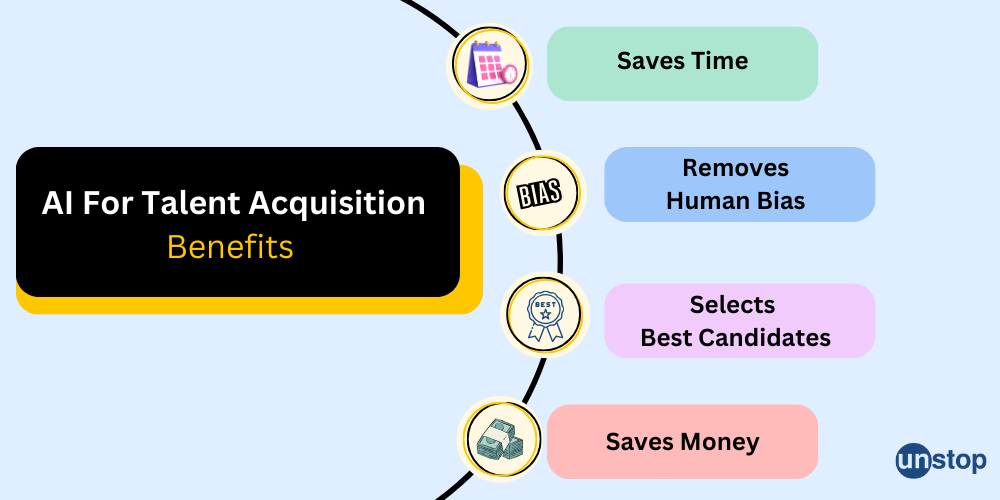
Cost-Efficiency in Recruitment
AI has revolutionized the talent acquisition process, bringing numerous benefits to businesses. One significant advantage is the cost-efficiency it offers. By automating manual processes, AI reduces recruitment costs significantly. Instead of spending valuable time and resources on repetitive tasks, HR professionals can focus on strategic initiatives.
With streamlined workflows powered by AI, there is no longer a need for multiple tools and platforms. Everything can be managed within a single system, saving both time and money. From sourcing candidates to scheduling interviews and conducting assessments, AI simplifies the entire recruitment process.
Improved Onboarding with AI
Another area where AI proves invaluable is in improving the onboarding experience for new hires. Virtual onboarding platforms leverage AI technology to provide a seamless integration process. These platforms offer personalized training programs that cater to individual needs, ensuring employees feel supported from day one.
AI-powered systems also enable organizations to develop comprehensive employee development plans. By analyzing data and identifying growth opportunities, businesses can create personalized paths for career progression. This not only enhances employee satisfaction but also boosts long-term retention rates.
Attract top talent by building your employer brand! Let's break it down for you, shall we?
Long-Term Retention and Development
AI's impact extends beyond the initial stages of recruitment and onboarding; it plays a crucial role in long-term retention and development as well. Through continuous feedback and coaching, AI-driven systems help improve employee performance over time.
By leveraging AI and ML for talent acquisition, companies can analyze vast amounts of data to identify areas where individuals may need additional support or training. This proactive approach ensures that employees receive the guidance they need to succeed while fostering a culture of continuous improvement.
What do the stats say about AI for talent acquisition?
Take a look at how using AL and ML for talent acquisition has been fruitful for companies.
- A survey by SHRM (the Society for Human Resource Management) shows that 1 in 4 organizations report using automation or artificial intelligence (AI) to support HR-related activities, including recruitment and hiring. 85 percent of employers that use automation or AI say it saves them time and/or increases their efficiency.
- McKinsey research shows that organizations with strong use of AI and people analytics see an 80 percent increase in recruiting efficiency, a 25 percent rise in business productivity, and a 50 percent decrease in attrition rates.
- According to a study conducted by Deloitte, organizations that use AI in their talent acquisition process experience a 50% reduction in time to hire. This is a significant improvement compared to traditional methods, which can be time-consuming and inefficient.
While AI offers significant benefits, there are some challenges that companies must foresee for the seamless incorporation of AI and ML for talent acquisition.
Overcoming Challenges in AI-Driven Talent Acquisition
Addressing Data Privacy Concerns
Data privacy is a top concern. However, AI systems prioritize data privacy and security by ensuring compliance with data protection regulations. Transparent data handling practices are put in place to build trust with candidates. By being transparent about how candidate data is collected, stored, and used, organizations can alleviate concerns and foster confidence in their AI-driven recruitment processes.
Mitigating Bias in Screening
Another challenge that AI helps overcome in talent acquisition is bias in candidate screening. Traditional recruitment methods may inadvertently introduce biases based on factors like gender or ethnicity. With AI algorithms, objective criteria are used to evaluate candidates fairly and consistently. These algorithms analyze candidate attributes without any preconceived notions or biases.
To further ensure fairness, bias detection tools can be employed to identify and rectify potential biases within the AI system itself. By mitigating bias in the screening process, organizations can create a more inclusive and diverse workforce.
Managing AI Implementation Costs
The implementation costs of AI technology can be a concern for organizations considering its adoption for talent acquisition. However, proper planning plays a crucial role in reducing these costs. Organizations should assess their specific needs and goals before implementing an AI system.
Scalable solutions offer cost-effective options for organizations of all sizes. These solutions allow businesses to start small and gradually expand their use of AI as they see positive results.
To determine the value of their investment, organizations should conduct a return on investment (ROI) analysis. This analysis helps evaluate the benefits gained from implementing an AI-driven talent acquisition system against the associated costs.
Starting with AI in Talent Acquisition
Evaluating Organizational Needs
To successfully implement AI in talent acquisition, it is important to evaluate organizational needs. By assessing pain points and specific requirements, companies can make informed decisions about adopting AI solutions. This evaluation process helps target the right tools and technologies that align with recruitment goals.
For example, if a company struggles with high volumes of applications, an AI tool that can automate resume screening would be beneficial. Understanding these needs ensures that the chosen AI technology addresses the organization's unique challenges.
Choosing the Right AI Tools
Researching and evaluating different AI tools is an essential step in leveraging AI for talent acquisition. Companies should consider factors such as key features, ease of use, and compatibility with existing systems. For instance, a tool that uses natural language processing to analyze candidate responses during interviews may be highly regarded by HR professionals. By carefully selecting the right AI tools, organizations can enhance their recruitment processes and improve overall efficiency.
Remember!
Don't miss out review and recommenddations before you select a tool. User reviews and recommendations can provide valuable insights into the effectiveness of different tools. Reviews come from a variety of users with different needs, budgets, and company cultures. This diversity provides a well-rounded picture of the tool's strengths and weaknesses across different contexts. Also, user reviews are often unfiltered and unbiased, offering a more realistic view of the tool's capabilities.
Developing an AI Integration Plan
A well-defined integration plan is a prerequisite for successful implementation of AI in talent acquisition. Collaboration between HR, IT departments, and stakeholders is essential to ensure a smooth transition.
Testing and piloting phases help identify any potential disruptions or issues before full deployment. This phased approach minimizes risks associated with integrating new technologies into existing systems. With a clear plan in place, organizations can effectively train employees on how to use the new AI tools and address any concerns or resistance to change.
Taking the Hybrid Approach to Talent Acquisition - Human Expertise + AI
A blended approach that combines human expertise with AI capabilities is proving to be highly effective. By leveraging the power of AI tools while also incorporating human judgment and contextual understanding, organizations can optimize their recruitment outcomes.
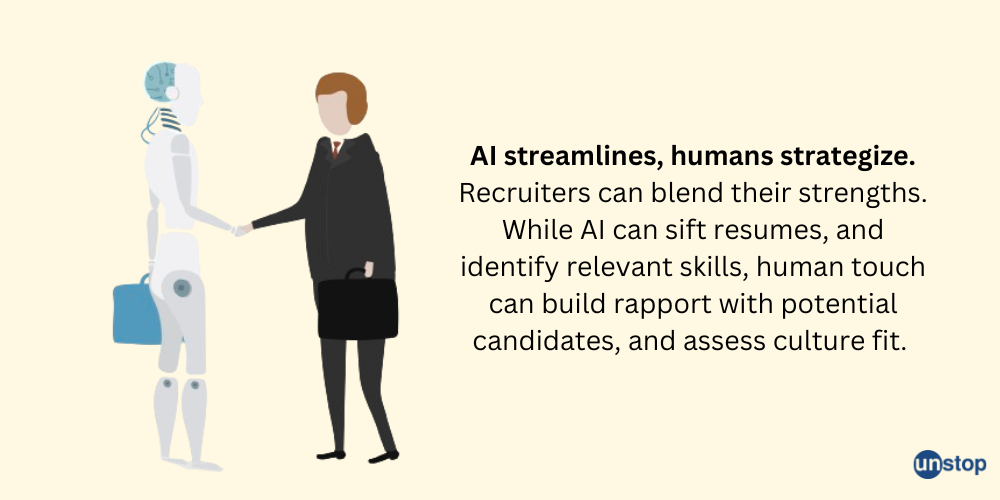
Collaboration between recruiters and AI technologies allows for a more comprehensive evaluation of candidates. While AI tools can quickly analyze large volumes of data and identify potential matches based on skills and qualifications, human recruiters bring their expertise in assessing soft skills and cultural fit. This combination ensures that hiring decisions are not solely based on algorithms but take into account the nuanced factors that contribute to successful team dynamics.
Benefits of a Blended Model
- Implementing a blended model in talent acquisition offers several benefits. Firstly, it improves efficiency by automating time-consuming tasks such as resume screening and initial candidate assessments. This frees up recruiters' time to focus on building relationships with candidates and conducting more personalized interactions.
- Secondly, the collaboration between humans and AI enhances accuracy in candidate selection. While AI algorithms can eliminate biases in the screening process, human recruiters provide crucial context that helps refine the decision-making process further.
- Lastly, a blended model enhances the candidate experience. Personalized interactions facilitated by human recruiters create a positive impression on candidates throughout the recruitment journey. This personalized touch demonstrates an organization's commitment to understanding individual needs and preferences.
Future Landscape of AI in Talent Acquisition
As per a Deloitte survey, 53% of organizations are redesigning their HR programs to incorporate digital technologies, while 22% have started using AI to offer HR solutions. Ongoing advancements in AI are shaping the future of talent acquisition. As technology continues to evolve, recruiters have access to a range of emerging tools and solutions that offer new possibilities. These AI-powered innovations are designed to meet the changing needs of the industry.
For example, chatbots powered by natural language processing (NLP) algorithms can engage with candidates, answer their questions, and provide real-time assistance throughout the hiring process. This not only streamlines communication but also enhances the candidate experience.
Another innovation is AI-powered resume screening software that automates the initial screening process by analyzing resumes for relevant skills and qualifications. This saves recruiters time and effort while ensuring a more efficient evaluation of candidates.
Preparing for AI Evolution in HR
HR professionals must adapt to the evolving landscape of AI in talent acquisition. Continuous learning and upskilling are essential to stay ahead in this rapidly changing field. By embracing change and acquiring new skills, HR professionals can foster innovation and make the most of AI technologies.
For instance, understanding how to leverage data analytics can help HR professionals gain valuable insights into talent trends, optimize recruitment strategies, and make data-driven decisions. Learning about ethical considerations surrounding AI usage ensures responsible implementation within recruitment processes.
Ethical Considerations in AI Usage
As organizations increasingly rely on AI for talent acquisition, it is crucial to adhere to ethical guidelines. Ensuring fairness, transparency, and accountability when using AI systems is paramount. Regular audits should assess the ethical implications associated with these technologies.
One important consideration is avoiding bias during candidate selection. While AI algorithms can assist with screening resumes or conducting interviews, they must be trained on diverse datasets free from discriminatory biases. This helps prevent unfair treatment or discrimination against certain groups of applicants. Maintaining transparency about how AI systems operate is vital for building trust among candidates and stakeholders and utilizing this technology to the fullest for talent acquisition.
Frequently Asked Questions
What is the role of AI in talent acquisition?
AI plays a transformative role in talent acquisition by automating repetitive tasks, improving candidate sourcing and screening, enhancing candidate experience, and providing data-driven insights for informed decision-making.
How does AI benefit business recruiting?
AI benefits business recruiting by reducing time-to-hire, improving the quality of hires, increasing efficiency in candidate screening, enhancing diversity and inclusion efforts, and enabling recruiters to focus on strategic activities.
What are the challenges in AI-driven talent acquisition?
Challenges in AI-driven talent acquisition include potential bias in algorithms, lack of transparency in decision-making processes, data privacy concerns, initial investment costs, integration with existing systems, and ensuring effective human-AI collaboration.
How can organizations start with AI in talent acquisition?
Organizations can start with AI in talent acquisition by identifying specific pain points or areas where AI can add value. They can pilot AI solutions for tasks like resume screening or chatbot-based candidate engagement and gradually expand their implementation based on results and feedback.
What is the future landscape of AI in talent acquisition?
The future landscape of AI in talent acquisition will likely see continued advancements such as predictive analytics for candidate fit assessment, virtual reality simulations for assessing skills, automated interview scheduling using natural language processing (NLP), and increased adoption of AI-powered recruitment tools across industries.
Suggested Reads:
- What Is Simulation-Based Training And Why Your Company Needs It?
- Succession Planning: A Comprehensive Guide for HR Professionals
- Employee Skill Gap Analysis: What Is It & How To Conduct It?
- How Simulations Help In Developing Economics Skills Among Students & Employees?
- Upskill And Reskill: The Learning Approaches Shaping Professional Development Today
As a biotechnologist-turned-writer, I love turning complex ideas into meaningful stories that inform and inspire. Outside of writing, I enjoy cooking, reading, and travelling, each giving me fresh perspectives and inspiration for my work.
Login to continue reading
And access exclusive content, personalized recommendations, and career-boosting opportunities.
Subscribe
to our newsletter
Blogs you need to hog!

What is Campus Recruitment? How To Tap The Untapped Talent?
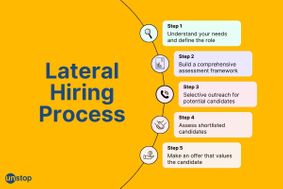
Lateral Hiring: A Complete Guide To The Process, Its Benefits, Challenges & Best Practices
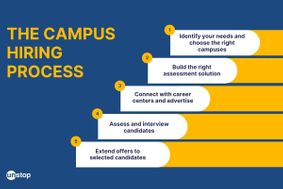
Step-By-Step Approach To Building A Winning Campus Recruitment Strategy
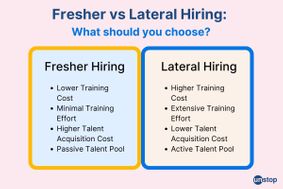












Comments
Add comment